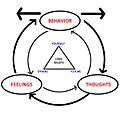Post-traumatic stress disorder facts for kids

Post-traumatic stress disorder (often called PTSD) is a type of anxiety disorder. It can happen when someone experiences or sees something very upsetting or scary. This might be a serious accident, a natural disaster, or a violent event.
PTSD is different from regular stress. Regular stress is usually less intense and doesn't last as long. PTSD was known by other names in the past, like shell shock or traumatic war neurosis, especially when soldiers experienced it after battles.
Contents
What is PTSD?
PTSD is a condition that affects a person's mind and body after a very frightening event. It's not just feeling sad or scared for a short time. People with PTSD might feel scared or unsafe long after the danger has passed.
How PTSD Affects People
People with PTSD can have different symptoms. These might include:
- Flashbacks: Feeling like the event is happening again.
- Nightmares: Bad dreams about the event.
- Avoiding things: Staying away from places, people, or activities that remind them of the event.
- Strong reactions: Being easily startled or feeling on edge all the time.
- Negative thoughts: Feeling sad, numb, or having trouble remembering parts of the event.
These feelings can make it hard to do everyday things like go to school, sleep, or spend time with friends and family.
History of PTSD
Even though the name "PTSD" is somewhat new, people have experienced these symptoms for a very long time. For example, after the Great Fire of London in 1666, a man named Samuel Pepys wrote in his diary about his fears. Six months after the fire, he still couldn't sleep well because he was so afraid of another fire. This sounds a lot like what we now call PTSD.
PTSD in Soldiers
Throughout history, soldiers have often experienced symptoms of PTSD after returning from war. In World War I, it was called "shell shock." This was because people thought the loud explosions from shells caused the problem. Later, in World War II and the Vietnam War, it was called "combat stress reaction" or "war neurosis." Today, we understand that it's a mental health condition caused by the trauma of war.
Getting Help for PTSD
It's important for people with PTSD to get help. There are different ways to treat PTSD, and they can help people feel better.
Types of Support
- Therapy: Talking to a trained professional, like a therapist or counselor, can help. They teach ways to cope with difficult memories and feelings.
- Support groups: Talking with others who have similar experiences can help people feel less alone.
- Medication: Sometimes, doctors might suggest medicine to help with symptoms like anxiety or trouble sleeping.
Getting help can make a big difference. It helps people learn to manage their symptoms and live happier, healthier lives.
Images for kids
See also
 In Spanish: Trastorno por estrés postraumático para niños
In Spanish: Trastorno por estrés postraumático para niños






